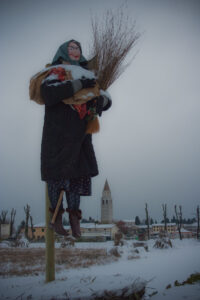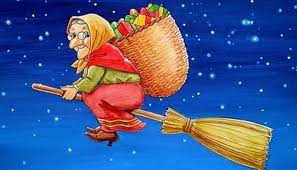Today in Italy they celebrate Befana. Oggi in Itaia e'la festa della Befana.
At the end of the calendar year, the holiday cycle ends on January 6 - Epiphany, and the people say that after that date the holidays go away. The term "Epiphany" is of Greek origin and means "manifestation"; it is used by Christian tradition to indicate the first manifestation of the divinity of Jesus Christ, in the presence of the Magi. In folk tradition, however, the term Epiphany (Epiphany), which has passed into Befana, acquires a different meaning, describing the image of a special old woman. Like most Italian traditions and holidays throughout the year, this one has rural origins, rooted in the agricultural past. In antiquity, on the twelfth night after Christmas or after the winter solstice, the death and rebirth of nature was celebrated, through the figure of Mother Nature.
You can read more about Italy and its culture in the bilingual Almanac
Puoi leggere di più sull'Italia e sulla sua cultura nella Raccolta bilingue
Con la fin dell'anno solare, il ciclo dei festeggiamenti si concludes il 6 gennaio, il giorno dell'Epifania per la quale il popolo says che "tutte le feste porta via". The term "Epiphany", of Greek origin, means "manifestazione" in the sense of divinity, and was used by the Christian tradition to designate the first manifestation of Jesus Christ, which took place in the presence of the Magi. Nella tradizione popolare però il termine Epifania, si è simplicato in Befana, ha assunto un significato diverso, andando a designare la figura di una vecchina particolare. Come le altre tradizioni italiane che si svolgono in tutto l'arco dell'anno, anche questa festività ha un'origine rurale, affondando le radici nel passato agricolo. Anciently, infacti, la dodicesima notte dopo il Natale, ossia dopo il solstizio wintera, si celebrava la morte e la rinascita della natura, traverso la figura pagana di Madre Natura.
 On the night of January 6, Mother Nature, tired of giving her energy during the year, appears in the form of an old woman, a good witch, who flies in the sky on her broom. Now withered, Mother Nature is ready to be burned like a branch, so that she can then be reborn from the ashes as a young Nature, a new moon. Before she dies, however, the old woman passes by and distributes gifts and treats to everyone, as if planting the seeds that will be born in the coming year. In many regions of Italy, during this period, purification rites similar to those of Carnival are carried out, driving evil from the fields by ringing bells that make a great noise or by lighting fires, and in some regions straw dolls are built that are beaten lit on the night between January 5 and 6. The children eagerly await Befana, hanging stockings on the mantelpiece. The old woman gives goodies to the obedient children, and coal to the disobedient ones.
On the night of January 6, Mother Nature, tired of giving her energy during the year, appears in the form of an old woman, a good witch, who flies in the sky on her broom. Now withered, Mother Nature is ready to be burned like a branch, so that she can then be reborn from the ashes as a young Nature, a new moon. Before she dies, however, the old woman passes by and distributes gifts and treats to everyone, as if planting the seeds that will be born in the coming year. In many regions of Italy, during this period, purification rites similar to those of Carnival are carried out, driving evil from the fields by ringing bells that make a great noise or by lighting fires, and in some regions straw dolls are built that are beaten lit on the night between January 5 and 6. The children eagerly await Befana, hanging stockings on the mantelpiece. The old woman gives goodies to the obedient children, and coal to the disobedient ones.
La notte del 6 gennaio, infatti, Madre Natura, stanca per aver donato tutte le sue energie durante l'anno, appariva sotto forma di una vecchia e benevola strega, che volava per i cieli con una scopa. Oramai secca, Madre Natura era pronta ad essere bruciata come un ramo, per far sì che potesse rinascere dalle ceneri come giovane Natura, una luna nuova. Prima di perire però, la vecchina passava a distributere dei doni e dolci a tutti, in modo da piantare i semi che sarebbero nati durante l'anno succeedivo. In molte regioni italiane infacti, in questo periodo, si eseguno diversi rites purificatori simili a quelli del Carnevale, in cui si scaccia il maligno dai campi grazie a campanacci che fanno grand chiasso o accendendo imponenti fuochi, o even in alcune regioni building dei phantoms di paglia, che vengono bruciati nella la notte tra il 5 ed il 6 gennaio.
© 2024 Iliana Dechkova

